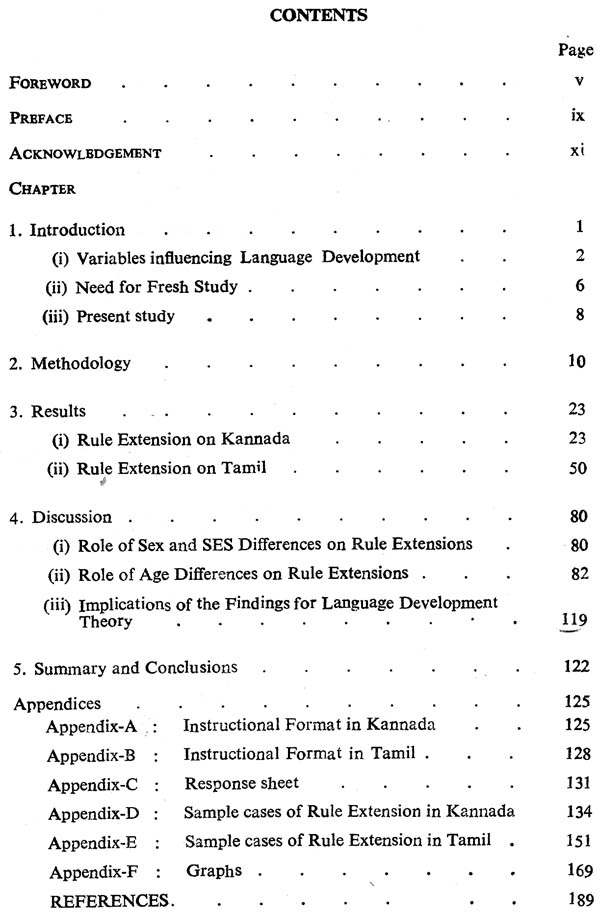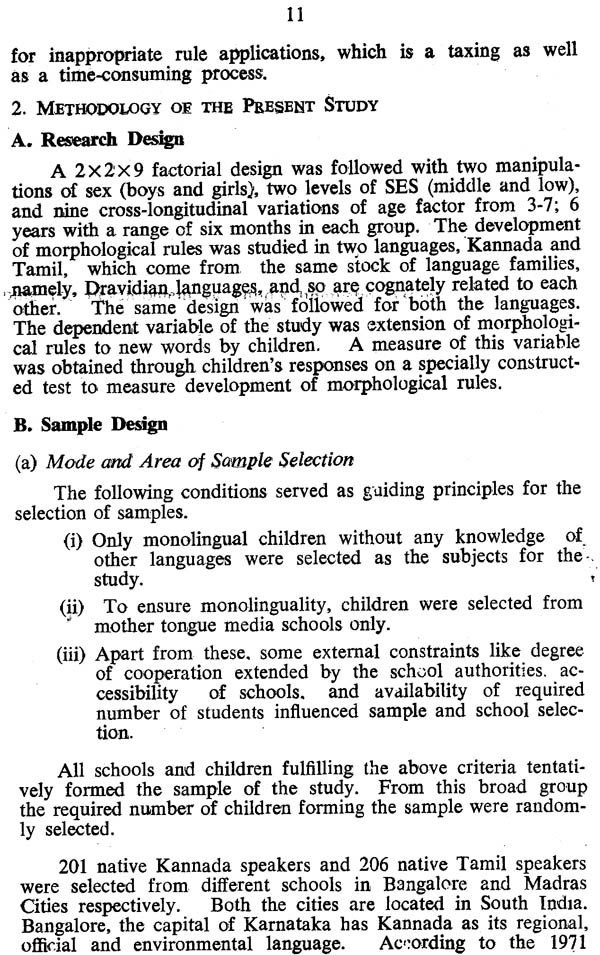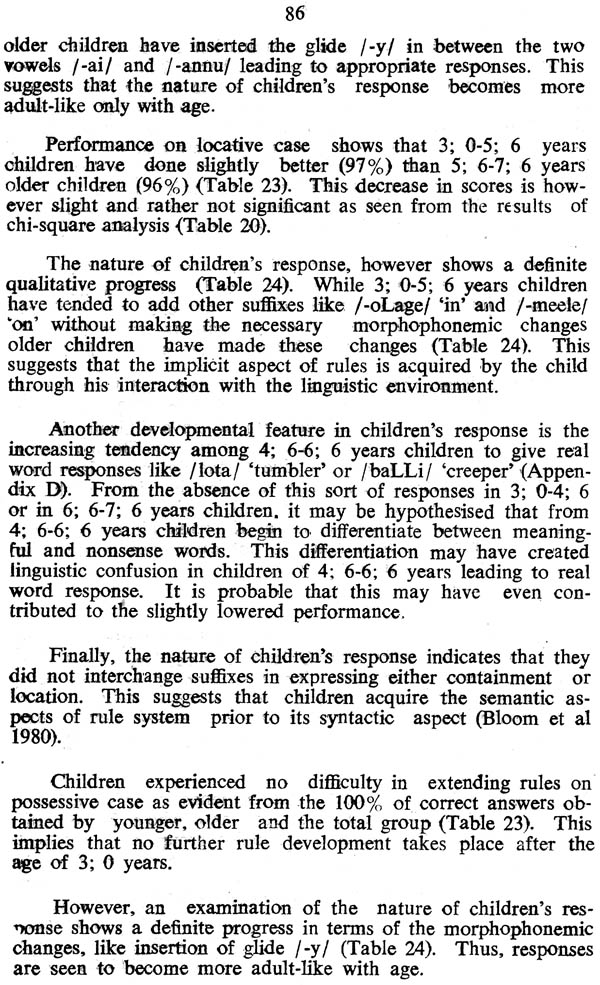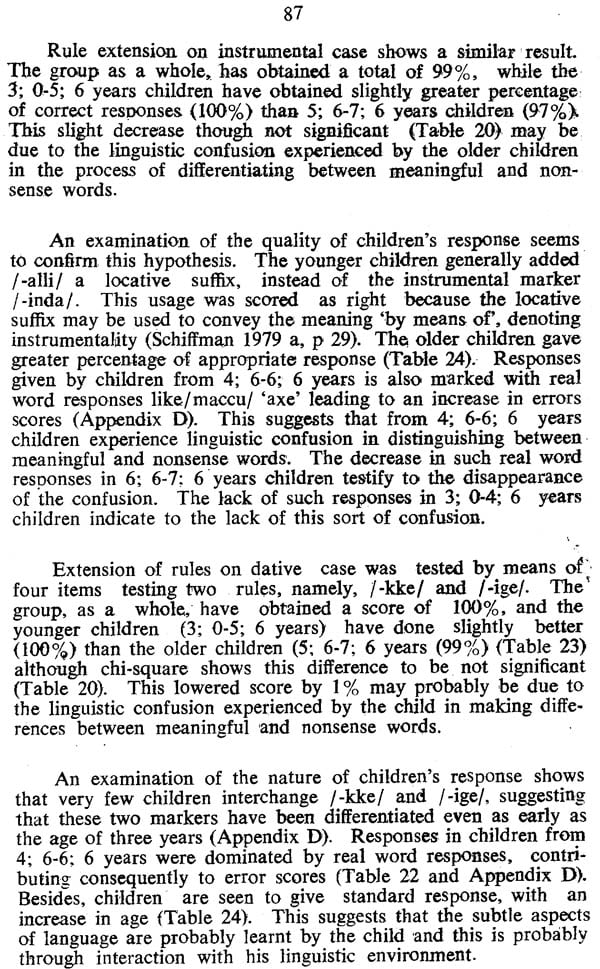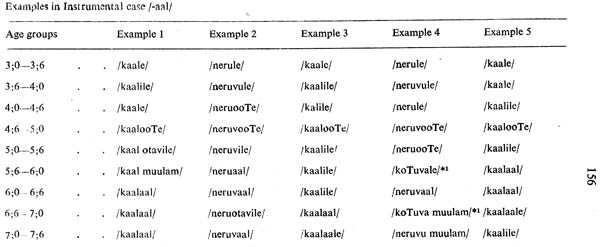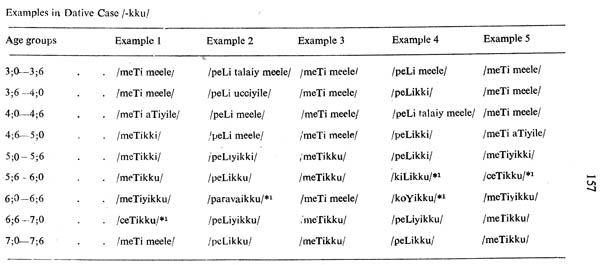
Development of Morphological Rules in Children (An Old book)
Book Specification
| Item Code: | NAW393 |
| Author: | L. Devaki |
| Publisher: | Central Institute Of Indian Languages, Mysore |
| Language: | English |
| Edition: | 1991 |
| Pages: | 208 |
| Cover: | PAPERBACK |
| Other Details | 8.00 X 6.00 inch |
| Weight | 230 gm |
Book Description
One of the research programmes of the Central Institute of Indian Languages is to encourage learner centred interdisciplinary research. Such learner centred interdisciplinary research comes generally under the purview of psycholinguistics. The field of psycholinguistics is just a few decades old. In our country its birth is, however very recent. Yet, it is heartening to note that the CIIL has several works to its credit in this area.
Some of the works initiated by the CIIL include effects of medium of instruction on achievement, cognitive abilities and personality, an annotated bibliography on bilingualism, bilingual education and medium of instruction both in the area of bilingualism, simultaneous acquisition of two languages in developmental psycholinguistics and social psycholinguistics, language of as phasic in clinical psycholinguistics, compatibility of language use in school textbooks ‘in applied psycholinguistics and silent talk, a work on non-verbal communication in social psycholinguistics. The present work, ‘Development of Morphological Rules in Children’ is in the area of developmental and experimental psycholinguistics (Prideaux 1984). I have been closely associated with this work in the twin capacities of a supervisor and an editor.
In the broader context, the issue of language acquisition has been examined by scholars of diverse disciplines like linguistics, psycholinguistics, sociolinguistics, neurolinguistics and so on. Corresponding to this expansion of research among disciplines is also an expansion of analysis from merely describing and analysing language to doing the same in a context- bound situation. Further, the studies on language acquisition have also shifted from examining language acquisition at a macro level to a micro level. These shifts have however contributed to rather than mitigating the differences of opinion among scholars coming from different disciplines and also among scholars coming from the same discipline. Thus linguistically oriented psycholinguists claim that language is acquired through rules (Chomsky 1965). But psychologically oriented psycholinguists claim that language is learned through learning individual items (Skinner 1957). Even among psychologically oriented psycholinguists it is claimed that opera conditioning is used for language learning (Skinner 1957). For still others, classical as well as operant conditioning are used to learn a language (Staats 1968). Currently, however, irrespective of the disciplinary orientations the emphasis ‘s on interactional approach where the roles of both item and rule learning are recognised. Further, language development itself is being viewed as a dynamic process undergoing various changes in the process of development. However even this view is not free from controversies (Brown 1970 and Cromer 1983).
This monograph reflects these views and tries to empirically establish the process of language development. The author is to be congratulated for drawing our attention to the subtleties of language development with respect to two cognate Indian languages, Kannada and Tamil. The cross-linguistic comparison between these two languages showing similarities and differences in development of morphological rules in children is another significant aspect of the work.
Finally, a research work lives not by itself but through the amount of work it is able to generate. The CIIL will be happy if similar such works are conducted across non cognate languages and across monolingual and bilingual developmental contexts.
The study of child language is at present in a State of flux; it is becoming more and more elaborate in its methodology, and microscopic in the matter of structural examination. As a result, researchers working in this area are constantly forced to draw in, and depend upon mere and more researches from other disciplines like Philosophy, Sociology, Anthropology, Psychology, Neurology, Speech Pathology and so on apart from researches in Linguistics proper. These inter- actions, have on the whole, resulted in mute benefit and have also widened the scope of Linguistics.
One beneficial outcome of this interaction, particularly between Psychology and Linguistics, is the reciprocal enrichment of methodology. For example, Berko (1958) a Psychologist, has devised an ingenious method of testing children which is used even to this day by researchers in this field (Derwing and Baker 1977 and 1979 and Sridhara 1980).
Using this methodological innovation, an attempt is made in the present study to test children’s know- ledge of morphological rules through their rule extension behaviour, across sex, socioeconomic status and age of the language learner. This study was conducted in relation to two Indian cognate languages, Kannada and Tamil, with a developmental perspective. 201 Kannada mother tongue speakers and 206 Tamil mother tongue speakers were randomly selected from mother tongue media schools, categorised for their socio-economic status and the test on development of morphological rule was individually administered.
The data obtained were processed and analysed over morphological categories, in relation to sex, socio-economic status and age of children, using ANOVA, Chi-square and ‘t’ test techniques. Taking the assistance of qualified statisticians, the data were analysed through a computer. Some qualitative analyses were also undertaken to obtain an insight into the nature of rule extension.
The present monograph, which is the outcome of the above mentioned study, has been divided into five chapters. The first chapter, which is introductory in character, gives the background of the study, critically reviews other works on the variables like sex, socio-economic status and age, and brings out the need for the present study. The second chapter deals with the methodology of the study. In Chapter III the results obtained on Kannada and Tamil monolingual samples are presented separately. Chapter IV discusses the implications of these results for variables sex, socio-economic status and age on Kannada and Tamil monolingual children, along with a cross-linguistic comparison. The entire study, along with conclusions is presented briefly in Chapter V.
Five appendices A, B, C, D, E have been included at the end. Appendices A and B contain instructions to children for eliciting responses from them in respect of rule extension over morphological eateries in Kannada and Tamil languages. Appendix C is the response sheet for recording the children’s responses. Appendices D and E relate to children’s responses from five randomly selected samples in each age-group highlighting the developmental features. Graphs illustrating quantitative aspects of development in younger and older children have also been included at the end.
"The flute is sweet and the guitar is dulcet: So say they who have not heard the babbling speech of their little ones", Thus says the Tamil poet Tiruvalluvar, highlighting the sweetness contained in the child’s language. Certainly, a child’s language’ is sweet to the parent’s ears because to their emotional attachment to their children. But other features of a child’s language, such as, its linguistic regularity and amazing speed of development has captivated the scientists, generating an enormous body: of research. These studies are aimed at answering the question of how language develops in children.
One of the earliest study was conducted by the mogul emperor Akbar (1542-1605) who had a palace called Gang Mahal the ‘dumb palace’ built. He reared children in this palace with- out exposing them to language in order to provide an answer to this question (Crystal 1987). Later studies conducted by other researchers were marked by greater degrees of scientific rigour and continued to examine this question at a micro-level taking specific aspects of language. The present Study in line with this trend examined the development of morphological rules In children. This study was undertaken by analysing children’s ability to extend morphological rules to new instances (Berko 1958, Derwing and Baker 1979 and Sridhara 1980). The development of rules was inferred from such applications of rule regularities to new situations (Slobin 1971C).
Several variables influence the Process of language development. A discussion of the role of these variables is essential for an understanding of the controversial issues involved in them. The factor of intelligence has not been taken into consideration on the assumption that intelligence is not a crucial variable in the study of normal population with normal language development (Deich and Hodges 1977). In comparing normal and retarded sample or sample with and without problems in language development, this variable assumes importance. However, in a normal sample, the random sample selection is expected to control the effect of this variable. Other variables like age, Sex, socioeconomic status (henceforth SES) and nature of language, may however, influence the developmental course.
I. VARIABLES INFLUENCING LANGUAGE DEVELOPMENT
A. Effect of Age on Language Development :
The age factor exerts tremendous amount of influence on all aspects of cognitive development, including language. Historically, this was one of the first variables to be examined in relation to language development. The age-wise examination of language development has become quite pervasive and has in fact opened up new vistas of psycholinguistic studies called the ‘developmental psycholinguistics’.
Age is a crucial variable in as much as the process of language development begins earlier than two years and is completed by the time the child attains five years of age. It is customary to talk of a particular aspect of linguistic development emerging at a particular age. Such developmental schedules help m evaluating the normal and retarded developmental course.
However, the relationship between age and language development is not as simple as it seems to be. Studies on global aspect of linguistic development show that language development increases with age (Leopoid 1939, Brown, Cazden and Bellugi 1969, Brown 1970, de Villers and de Villers 1976). Studies on specific aspect of linguistic development, such as development of questions (Smith 1978), requests (Garvey 1978), word meaning (Clark 1973) and morphological development (Berko 1958, Derwing and Baker 1977 and 1979 and Sridchara 1980) confirm this progressive age-related improvement.
Interestingly, other studies do not support this view. These studies show that the child’s language changes qualitatively rather than quantitatively. That is from global and undifferentiated process to specificity and differentiation and this is attributed to age-related factors. Studies on acquisition of datives (Ingram 1985), modals (Menyuk 1969), negatives (Bellugi 1967), plurals (Ervin Tripp and Miller 1964 and Slobin 1966), relational terms (French and Nelson 1985), Syntax (Chomsky 1969) and words (Cromer 1983) report such findings. Further, it also appears that the age at which qualitative differences emerge vary with the linguistic system that is acquired. Cromer (1983) observes that in the acquisition of words. two-year old children do better than three year old children and four-year old children. the later age groups being the transitional periods. However, five- year old’s show a superior performance in acquisition of lexicon. White (1966) studying the pattern of learning claims that differences appear with age and a change occurs at the age of five.
She suggests that this Change may be related to reorganisation of brain chemistry. For French and Nelson (1985) who investigated the acquisition of relational] terms the transitional period is at 40 years.
Thus there are controversies not only with regard to the age-related development but also in relation to the age at which differences appear, For Cromer (1983) the transitional period begins at three years, but according to White (1966) it is at five years of age. All these seem to suggest that the aspect of linguistic development that is under consideration is an important intervening variable. Cromer (1983) examined acquisition of lexicon, but White (1966) investigated patterns of word associations and language learning.
In the light of these contradictory findings the age variable assumes crucial importance in the Study of language development. The role of this variable on development of an Indian language and in an Indian context has to be examined.
**Contents and Sample Pages**
